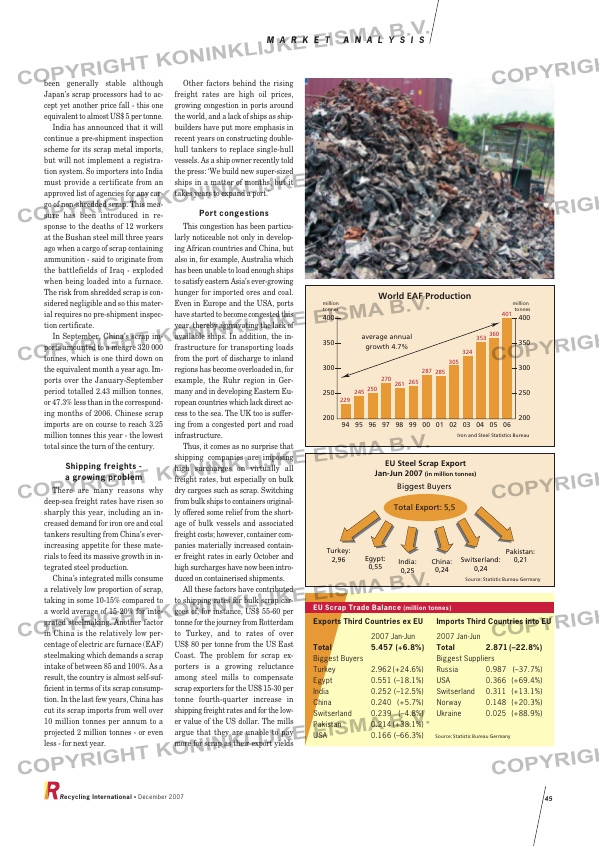Page 45 from: December 2007

M A R K E T A N A L Y S I S
been generally stable although
Japan’s scrap processors had to ac-
cept yet another price fall – this one
equivalent to almost US$ 5 per tonne.
India has announced that it will
continue a pre-shipment inspection
scheme for its scrap metal imports,
but will not implement a registra-
tion system. So importers into India
must provide a certificate from an
approved list of agencies for any car-
go of non-shredded scrap. This mea-
sure has been introduced in re-
sponse to the deaths of 12 workers
at the Bushan steel mill three years
ago when a cargo of scrap containing
ammunition – said to originate from
the battlefields of Iraq – exploded
when being loaded into a furnace.
The risk from shredded scrap is con-
sidered negligible and so this mater-
ial requires no pre-shipment inspec-
tion certificate.
In September, China’s scrap im-
ports amounted to a meagre 320 000
tonnes, which is one third down on
the equivalent month a year ago. Im-
ports over the January-September
period totalled 2.43 million tonnes,
or 47.3% less than in the correspond-
ing months of 2006. Chinese scrap
imports are on course to reach 3.25
million tonnes this year – the lowest
total since the turn of the century.
Shipping freights –
a growing problem
There are many reasons why
deep-sea freight rates have risen so
sharply this year, including an in-
creased demand for iron ore and coal
tankers resulting from China’s ever-
increasing appetite for these mate-
rials to feed its massive growth in in-
tegrated steel production.
China’s integrated mills consume
a relatively low proportion of scrap,
taking in some 10-15% compared to
a world average of 15-20% for inte-
grated steelmaking. Another factor
in China is the relatively low per-
centage of electric arc furnace (EAF)
steelmaking which demands a scrap
intake of between 85 and 100%. As a
result, the country is almost self-suf-
ficient in terms of its scrap consump-
tion. In the last few years, China has
cut its scrap imports from well over
10 million tonnes per annum to a
projected 2 million tonnes – or even
less – for next year.
Other factors behind the rising
freight rates are high oil prices,
growing congestion in ports around
the world, and a lack of ships as ship-
builders have put more emphasis in
recent years on constructing double-
hull tankers to replace single-hull
vessels. As a ship owner recently told
the press: ‘We build new super-sized
ships in a matter of months, but it
takes years to expand a port.’
Port congestions
This congestion has been particu-
larly noticeable not only in develop-
ing African countries and China, but
also in, for example, Australia which
has been unable to load enough ships
to satisfy eastern Asia’s ever-growing
hunger for imported ores and coal.
Even in Europe and the USA, ports
have started to become congested this
year, thereby aggravating the lack of
available ships. In addition, the in-
frastructure for transporting loads
from the port of discharge to inland
regions has become overloaded in, for
example, the Ruhr region in Ger-
many and in developing Eastern Eu-
ropean countries which lack direct ac-
cess to the sea. The UK too is suffer-
ing from a congested port and road
infrastructure.
Thus, it comes as no surprise that
shipping companies are imposing
high surcharges on virtually all
freight rates, but especially on bulk
dry cargoes such as scrap. Switching
from bulk ships to containers original-
ly offered some relief from the short-
age of bulk vessels and associated
freight costs; however, container com-
panies materially increased contain-
er freight rates in early October and
high surcharges have now been intro-
duced on containerised shipments.
All these factors have contributed
to shipping rates for bulk scrap car-
goes of, for instance, US$ 55-60 per
tonne for the journey from Rotterdam
to Turkey, and to rates of over
US$ 80 per tonne from the US East
Coast. The problem for scrap ex-
porters is a growing reluctance
among steel mills to compensate
scrap exporters for the US$ 15-30 per
tonne fourth-quarter increase in
shipping freight rates and for the low-
er value of the US dollar. The mills
argue that they are unable to pay
more for scrap as their export yields
Recycling International • December 2007 45
Biggest Buyers
EU Steel Scrap Export
Jan-Jun 2007 (in million tonnes)
Total Export: 5,5
Turkey:
2,96 Egypt:
0,55
India:
0,25
Switserland:
0,24
Pakistan:
0,21China:
0,24
Iron and Steel Statistics Bureau
World EAF Production
400
350
300
250
200
average annual
growth 4.7%
million
tonnes
million
tonnes
400
350
300
250
200
94
229
245 250
270
261 265
287 285
305
324
353
360
401
95 96 97 98 99 00 01 02 03 04 05 06
EU Scrap Trade Balance (million tonnes)
Exports Third Countries ex EU Imports Third Countries into EU
2007 Jan-Jun 2007 Jan-Jun
Total 5.457 (+6.8%) Total 2.871 (–22.8%)
Biggest Buyers Biggest Suppliers
Turkey 2.962 (+24.6%) Russia 0.987 (–37.7%)
Egypt 0.551 (–18.1%) USA 0.366 (+69.4%)
India 0.252 (–12.5%) Switserland 0.311 (+13.1%)
China 0.240 (+5.7%) Norway 0.148 (+20.3%)
Switserland 0.239 (–4.8%) Ukraine 0.025 (+88.9%)
Pakistan 0.214 (+38.1%)
USA 0.166 (–66.3%) Source: Statistic Bureau Germany
Source: Statistic Bureau Germany
RI_025 MA Ferrous:MA Ferrous 07-12-2007 09:12 Pagina 45



